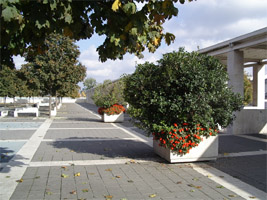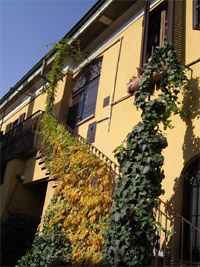 |
 |
 |
 |
 |
 |
 |
 |
 |
 |
 |
Introduction

Cities are reasonably regarded as the most complex non-natural ecosystems;
their viability and sustainability are however strongly dependant on Nature
– both around and within urban structures. The importance of the urban
greenery to people’s life and well-being as living Nature in the urban
context could be traced in many aspects and through a wide range of functions
- biological and ecological, social and technical, structural and psychological.
The most important contributions of urban green space to sustainability are
related to:
• Living comfort and human health - improving microclimate, supporting
air circulation, balancing air humidity and temperature, capturing dust and
gases;
• Urban metabolism – carbon storage and sequestration; retention
of storm water; recycling organic waste (by compost production) and upgrading
wastewater;
• Nature protection – preserving biodiversity as an important part
of natural heritage by sheltering a diverse mosaic of indigenous habitats and
species; providing opportunities for research and education; supporting effective
erosion and flood control policies;
• Diversified social and cultural environment to meet various individual
lifestyles and requirements of social and cultural life;
• Economic benefits – increasing the value of estates located by
quality green areas; energy savings in air conditioning; decrease in costs for
stormwater management and water treatment systems, etc.
Cities and towns in Europe have traditionally regarded green space important
to urban life. The first public parks and gardens in European cities have been
established in early 19th century (1819 in Budapest, 1829 in Magdeburg, 1843
in Birkenhead near Liverpool, etc). Historic parks are part of European cultural
landscape and are presently protected by international conventions and national
legislations. Access to green areas within a 15-minute walking distance is reported
possible today for more than 50% of the urban residents in the majority of European
cities (for 100% of the citizens in Brussels, Copenhagen, Glasgow, Madrid, Milan
and Paris and for 85% in Sofia). (EEA, 1995).
Urban green space is nowadays variously defined in different European countries. It is broadly understood as primarily planted public and private open spaces in urban areas or as “predominantly unsealed, permeable, ‘soft’ surfaces such as soil, grass, shrubs and trees together with buildings and hard covered surfaces belonging to them” in UK (ODPM, 2002), etc.


Recent international European research has provided some more comprehensive definitions. EC FP5 project on Urban Green Environment (URGE) regards urban green space as “public green spaces located in urban areas, mainly covered by vegetation which are directly used for active or passive recreation, or indirectly used by virtue of their positive influence on the urban environment, accessible to citizens, serving the diverse needs of citizens and thus enhancing the quality of life in cities or urban regions”. The urban green network is defined there as a system of ecologically connected green spaces in the city. Green spaces together with hard (paved) ‘civic’ spaces form the public open space (the open space, to which there is public access, even though the land may not necessarily be in public ownership or management). European COST Action C11 “Green Structure and Urban Planning” defines green spaces as "places within and around the city that carry human activity as well as plants, wildlife and water and their presence influences quality of life, as well as the quality of air and water”.
By linking the term ‘infrastructure’ to urban green space, implications of planning and management activities are added. According to a definition provided by COST C8 ‘Best Practice in Sustainable Urban Infrastructure” (case studies report), urban green/blue infrastructure consists of “all green areas of a city, private as well as public, gardens as well as areas of meadowland, woodland as well as parks or churchyards and rivers, wetlands, ponds. It also includes spontaneously self-established vegetation on deposits, road–sides, railway banks, green walls and roofs of buildings”. COST Action C11 explicitly points out that “green infrastructure is more than the sum of green spaces and implies drawing attention to the spatial network that links open spaces, public and private gardens, public parks, sports fields, allotment gardens and recreation grounds within the city to the networks of woodlands and river floodplains in the surrounding countryside”. It should be also reminded that although being regarded by both COST Actions and by PETUS project in the context of the technical urban infrastructure, the green/blue system is a living one. Its development is a result of a long-term interaction of natural and human systems and it needs patience and care to sustain.
The seven PETUS green/blue case studies focus on public open green spaces (inside or in close proximity with urban areas) in need of upgrading and regeneration. The projects reviewed aim at improving the quality of the green space, supporting local economy through new development or providing new places for recreation in ex-industrial brownfields.